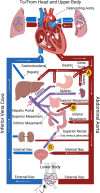Schistosome migration in the definitive host
- PMID: 32240157
- PMCID: PMC7117656
- DOI: 10.1371/journal.pntd.0007951
Schistosome migration in the definitive host
Abstract
Schistosomes are parasitic blood flukes that infect >200 million people around the world. Free-swimming larval stages penetrate the skin, invade a blood vessel, and migrate through the heart and lungs to the vasculature of the liver, where maturation and mating occurs. From here, the parasite couples migrate to their preferred egg laying sites. Here, we compare and contrast what is known about the migration patterns within the definitive host of the three major species of human schistosome: Schistosoma mansoni, S. japonicum, and S. haematobium. We conclude that intravascular schistosomes are inexorable colonizers whose migration and egg laying strategy is profligate; all three species (and their eggs) can be found throughout the mesenteric venules, the rectal venous plexus, and, to a greater or lesser extent, the urogenital venous plexuses. In addition, it is common for parasite eggs to be deposited in locations that lack easy access to the exterior, further demonstrating the relentless exploratory nature of these intravascular worms.
Conflict of interest statement
The authors have declared that no competing interests exist.
Figures



Similar articles
-
The Essential Ectoenzyme SmNPP5 from the Human Intravascular Parasite Schistosoma mansoni is an ADPase and a Potent Inhibitor of Platelet Aggregation.Thromb Haemost. 2018 Jun;118(6):979-989. doi: 10.1055/s-0038-1641715. Epub 2018 Apr 18. Thromb Haemost. 2018. PMID: 29669386
-
Prevalence and correlations of schistosomiasis mansoni and schistosomiasis haematobium among humans and intermediate snail hosts: a systematic review and meta-analysis.Infect Dis Poverty. 2024 Sep 2;13(1):63. doi: 10.1186/s40249-024-01233-0. Infect Dis Poverty. 2024. PMID: 39218903 Free PMC article.
-
Schistosoma mansoni x S. haematobium hybrids frequently infecting sub-Saharan migrants in southeastern Europe: Egg DNA genotyping assessed by RD-PCR, sequencing and cloning.PLoS Negl Trop Dis. 2025 Mar 31;19(3):e0012942. doi: 10.1371/journal.pntd.0012942. eCollection 2025 Mar. PLoS Negl Trop Dis. 2025. PMID: 40163525 Free PMC article.
-
Associations between schistosomiasis and HIV-1 acquisition risk in four prospective cohorts: a nested case-control analysis.J Int AIDS Soc. 2020 Jun;23(6):e25534. doi: 10.1002/jia2.25534. J Int AIDS Soc. 2020. PMID: 32585078 Free PMC article.
-
Schistosomiasis in Zambia: a systematic review of past and present experiences.Infect Dis Poverty. 2018 Apr 30;7(1):41. doi: 10.1186/s40249-018-0424-5. Infect Dis Poverty. 2018. PMID: 29706131 Free PMC article.
Cited by
-
RNA-seq gene expression profiling of the bladder in a mouse model of urogenital schistosomiasis.bioRxiv [Preprint]. 2024 Jun 29:2024.06.29.601185. doi: 10.1101/2024.06.29.601185. bioRxiv. 2024. PMID: 38979184 Free PMC article. Preprint.
-
Characterization of MicroRNA Cargo of Extracellular Vesicles Isolated From the Plasma of Schistosoma japonicum-Infected Mice.Front Cell Infect Microbiol. 2022 Feb 28;12:803242. doi: 10.3389/fcimb.2022.803242. eCollection 2022. Front Cell Infect Microbiol. 2022. PMID: 35295754 Free PMC article.
-
Parasitic helminth infections in humans modulate Trefoil Factor levels in a manner dependent on the species of parasite and age of the host.PLoS Negl Trop Dis. 2021 Oct 18;15(10):e0009550. doi: 10.1371/journal.pntd.0009550. eCollection 2021 Oct. PLoS Negl Trop Dis. 2021. PMID: 34662329 Free PMC article.
-
Monocyte and Macrophage-Mediated Pathology and Protective Immunity During Schistosomiasis.Front Microbiol. 2020 Aug 12;11:1973. doi: 10.3389/fmicb.2020.01973. eCollection 2020. Front Microbiol. 2020. PMID: 32922381 Free PMC article. Review.
-
Schistosomiasis.Adv Exp Med Biol. 2024;1454:75-105. doi: 10.1007/978-3-031-60121-7_3. Adv Exp Med Biol. 2024. PMID: 39008264 Review.
References
Publication types
MeSH terms
Grants and funding
LinkOut - more resources
Full Text Sources

